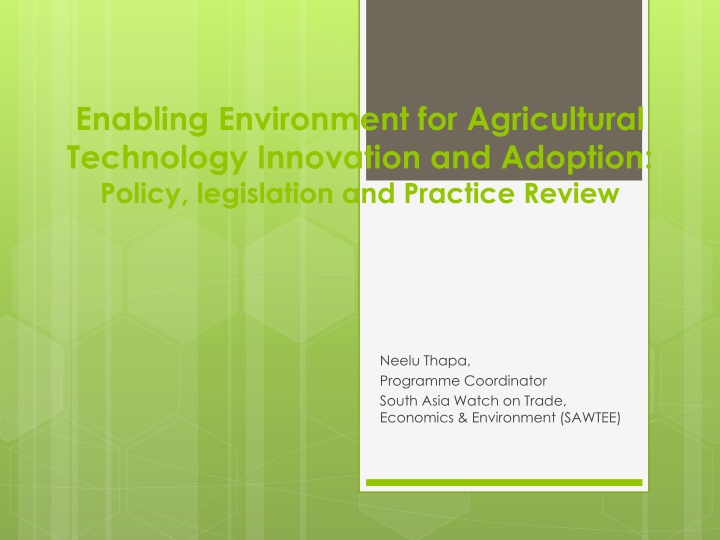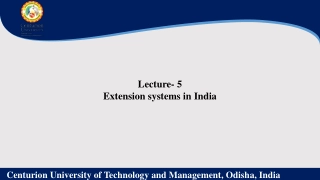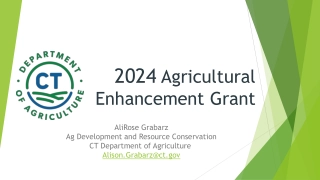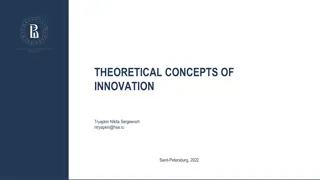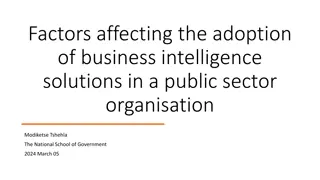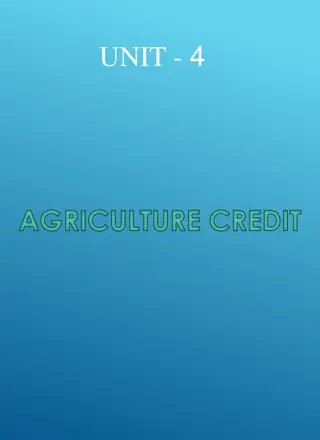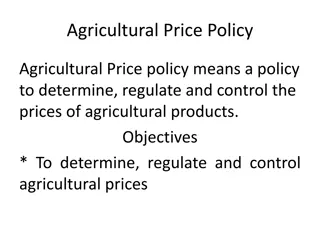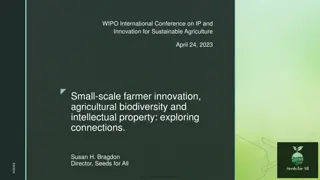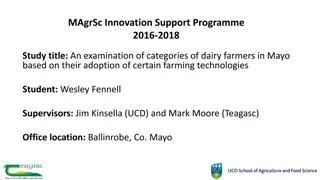Enhancing Agricultural Technology Adoption and Innovation: A Comprehensive Review
The review explores the interdependence of technology and the agricultural sector, focusing on Nepal's agriculture industry. It delves into issues like credit constraints, R&D, intellectual property rights, and sustainability challenges. Despite low productivity, agriculture remains crucial for development, with the need for strategic infrastructure and better technology interventions emphasized.
Download Presentation

Please find below an Image/Link to download the presentation.
The content on the website is provided AS IS for your information and personal use only. It may not be sold, licensed, or shared on other websites without obtaining consent from the author.If you encounter any issues during the download, it is possible that the publisher has removed the file from their server.
You are allowed to download the files provided on this website for personal or commercial use, subject to the condition that they are used lawfully. All files are the property of their respective owners.
The content on the website is provided AS IS for your information and personal use only. It may not be sold, licensed, or shared on other websites without obtaining consent from the author.
E N D
Presentation Transcript
Enabling Environment for Agricultural Technology Innovation and Adoption: Policy, legislation and Practice Review Neelu Thapa, Programme Coordinator South Asia Watch on Trade, Economics & Environment (SAWTEE)
Structure of the presentation Technology and Agriculture Sector: Interdependence Agriculture sector in Nepal Trade Dimension R&D and Technological Interventions Credit constraints Issues in sub sectors : Seed, Fertiliser, Mechanisation Intellectual Property Rights Discussion points
Technology and Agriculture sector Agricultural improvements and science and technology intertwined Agricultural improvements, e.g. the green revolution in India, largely a function of technological and institutional learnings entailing, inter alia, HYV seeds, fertilizers, irrigation and rural mechanization. While science and technology (the hard aspect) is crucial, instrumental also are the learnings for institutions and rural households among others (the soft aspects) Agriculture in developing countries scattered and largely a smallholder phenomenon: Impending still is linking the smallholders to infrastructures and markets Climate change and sustainability issues Credible learning and management towards sustainable, efficient and effective use of inputs
Agriculture sector in Nepal : An Overview Despite of low productivity, yield and inherent challenges in enabling growth, agriculture a major sector in addressing development challenges Financial system poorly geared in provisioning agricultural credit Poorly mapped value chains impede further expansion of such chains Low levels of mechanization: Inherent intricacies Increasing feminized agriculture Most policy documents fairly holistic in themselves and useful in strategizing the agricultural development challenges: Implementation, however is a daunting task
Continued Need for strategic infrastructure provisioning for greater technology interventions Poor deployment of improved varieties (Low SRRs) Narrow scope of extension services (largely towards seed provisioning) Mechanization and seed HYV deployment also constrained due to minimal attention towards the dynamics of learning and perception Smallholder farming a reality but understanding of mechanization focused on large farms
The Trade dimension Net importer of commodities such as rice, maize and vegetables among others mean major growth enhancing interventions required in agriculture Though there is export potential in specific commodities, compliance with SPS/TBT measures a major challenge due to both domestic capabilities and non-tariff barriers Severe impediments in SPS/TBT requirements (e.g Nepal has mandatory standards on 27 quality parameters but the standards on essential food safety parameters - MRLs, aflatoxins, microbial contaminants, and heavy metals are yet to be developed Inspection and analysis towards food safety standards focused largely on end products The development of regulatory framework in line with CODEX standards has been rather slow. Same could be said regarding the adoption of the standards of the International Office of Epizootics, and the International Plant Protection Convention Lacking facilities as well as human resources in testing and coordinating SPS issues and in enforcing inspections.
R&D and Technological Interventions ADS and NARC s Strategic Vision for Agricultural Research (2011-2030) have identified R&D as a core component: Could credible learning and emulation rather than innovation be the missing link? R&D efforts (e.g extension service provisioning) largely neutral towards contexts: agro-ecological regions and socioeconomic groups. Extension services remain largely underfunded and understaffed Development of private sector extension service providers an impending idea
Credit constraints The 2014 Finscope survey reports that less than a fifth of the Nepali adults have access to credit via formal institutions whereas banks cater to less than a tenth of all adults (IFAD, 2017). Overall bank lending to agriculture sector is at less than 8% while NRB has directed banks to lend at least 10% of their lending portfolio to agriculture sector including to farmers as well as agribusinesses (ibid.) Financial system, despite of regulations, appears poorly geared towards productive sector (agriculture) lending: Progress slow Minimal understanding of value chains and agricultural financing among FI officials Learning mechanisms few and learning poorly incentivized
Investment Foreign Direct investment in policy Foreign Investment Policy 2014 prioritizes agriculture. Earlier restricted, FDI in food processing and medicinal herbs processing now allowed A major analysis issue is how FDI in agriculture can be attracted when FDI in general remains low. Pertinent here is the fact that merely attracting FDI (campaigning for it) does not suffice. Crucial is to understand what are the linkages with the overall economy Credible mapping of value chains in agriculture (which also aids value chain expansion) is a major step to document profitable activities in agriculture. This can also aid FDI promotion
Seed Sector Improved seed varieties have a major role in productivity expansion: Improved seeds responsible for 50% yield improvement in the past five decades (Gauchan, 2017) Seed replacement rates remain low: Cereal (wheat, paddy) seed replacement rate less than 15% on average (ibid.). However, significant variation exists in deployment of HYVs even in cereals Current production levels for e.g. tomato hybrid seeds meet around 50% of the demand (Magar et al, 2016) Deployment of improved varieties subject to extension services as well as household specific characteristics such as wealth endowments and education (Ghimire et al, 2016) Insufficient motivation of breeders to produce varieties based on farmers changing needs; limited capacity to use modern techniques of plant breeding; inefficient production planning; Inadequate capacity of seed growers and insufficient knowledge and skills for processing and conditioning Gaps like noncompliance to seed quality assurance system; aging equipment, processing plants and techniques; inadequate seed dealers, channels and networks primarily in hills and mountain;
Fertilizer Fertilizer usage levels far below than that of other South Asian countries though agrovets penetration has been gradually addressing demand often through informal procurement. Supply is inconsistent and hence over three quarters of demand met informally: Challenges in demand forecasting and distribution MoAD has no system of regularly collecting farm-level data on the usage of fertilizers Mapping informal supplies from India difficult: Even more challenging to incentivize households towards formal sector purchasing though there are farmer group run demand mechanisms
Mechanization Mechanization rates, going by recent studies, continue to be low (only a quarter of land prepared using tractors for e.g. as suggested by Takeshima et al, 2015) The understanding and approach towards mechanization, however, in research, is limited: Neglect of small equipment led agricultural improvement in South East Asia (Biggs et al, 2015) though ADS does highlight small equipment such as 2WT To estimate the extent of mechanization current, stock of rural capital goods is crucial (one that takes into account local small equipment and tools such as small diesel pumps, 2WT etc): Credible surveying and research on small equipment required Poor road access and credit constraints are major impediments in mechanization The other issue is lack of awareness and absence of learning mechanisms in knowledge and usage of tools that cut drudgery: Scope of extension services narrow (largely geared towards HYV seeds)
Intellectual Property Rights TRIPS transition period upto 2021 IPR issues in seeds (CBD, TRIPS and growth of agriculture has intricate trade offs): Farmers right to save, exchange, reuse and traditional knowledge Cases where upto 80% seeds (in potato) are farmer saved ones (Gauchan et al, 2017)
Discussion points Broadening extension services scope beyond improved seeds provisioning (e.g. greater farmer participation in research and prioritization) Greater impetus to mechanization: Customization for smallholders farms and emulation of relevant best practices Incentivizing credit provisioning for agriculture sector Mapping value chains for expansion and development of value chains Gender equitable interventions Credible technology policy cross cutting sectors Increased investment in technological learning and greater deployment of it: Resources as well as mechanisms to ensure learning takes place Promoting non-traditional sector and associated exports given their potential: constraints relate not just to growth but also exports (SPS/TBT issues) Persistent implementation and policy enforcement challenges despite of near holistic policy documents:
